Historically, the upper central incisors have been the focal point of smile design. They establish facial symmetry by aligning with the dental midline and serve as the foundation for esthetic planning by dictating tooth proportions and the smile arc. Their position, assessed relative to the anterior cranial base and lower incisors, also contributes to arch coordination and long-term stability. But what if the key to the finer details of smile esthetics is a different tooth—the upper lateral incisor?
The upper lateral incisors are the most individualistic human teeth. They show the greatest left-right asymmetry and commonly exhibit congenital absence, microdontia, or morphological anomalies such as a peg shape, which occurs in approximately 2% of the population, appearing more frequently in women and twice as often on the left side.1 These variations make upper lateral incisor positioning critical in orthodontic treatment.
In my day, residents were taught to maintain lateral steps of .5-1mm incisally and .5mm lingually relative to the central incisors for natural smile curvature, but these guidelines tend to result in slightly prominent central incisors that dominate the smile. A modern understanding of smile esthetics favors longer, more labial lateral incisors with minimal lateral steps, which I believe make today’s smiles appear more elegant.
For patients in fixed appliances, I prioritize precise lateral incisor bracket positioning during initial bonding—accounting for any planned incisal enameloplasty—to minimize finishing and detailing adjustments. When wire bends are necessary, I typically transition to an undersized archwire, such as .017" × .025" stainless steel in .022" brackets, to step the upper lateral incisors slightly labially and incisally. I place each bend intraorally with a quick twist of a birdbeak plier.
Similar articles from the archive:
- THE EDITOR'S CORNER Management of Avulsed Permanent Teeth May 2025
- THE EDITOR'S CORNER Ortho-Heuristics April 2024
- THE EDITOR'S CORNER Axis Shrugged February 2024
Similarly, in nearly all clear aligner cases, I prescribe lateral incisor attachments for better control, since most of my refinement scans have resulted from patient dissatisfaction with the position of their lateral incisors. When more than .5mm of extrusion is necessary, I place 4mm gingivally beveled horizontal attachments at the incisal third. Research has shown that doctor-designed horizontal attachments are significantly more effective than AI-generated optimized attachments for lateral incisor extrusion.2
Even in young children, the appearance of the upper lateral incisors may be a concern. Flared or rotated lateral incisors in the early mixed dentition are pathognomonic for root impingement. Bonding these teeth can inadvertently shift their roots into the erupting canines. To mitigate this risk, I position the brackets with accentuated mesial root tip. Because this can cause excessive extrusion and flatten the smile arc, I initially place them in slightly incisal positions and then reposition them after the canines erupt.
Regardless of the patient’s age or treatment type, when the upper lateral incisors are undersized, maintaining a little space for future cosmetic dentistry is crucial. Some orthodontists prefer closing space only on the mesial side, while others center the tooth in the available space. Although parents may request complete consolidation, it risks leading to a Class II malocclusion. As Dr. Amanda Gallagher wisely advises, “Don’t make a restorative problem an orthodontic problem.”
No longer considered just a transition between the central incisor and canine, the lateral incisor plays a dynamic role in achieving smile symmetry. Even subtle variations in its position and shape can influence patients’ self-perception of age and beauty. When it comes to smile microesthetics, the upper twos just might be number one.
NDK
REFERENCES
- 1. Hua, F.; He, H.; Ngan, P.; and Bouzid, W.: Prevalence of peg-shaped maxillary permanent lateral incisors: A meta-analysis, Am. J. Orthod. 144:97-109, 2013.
- 2. Groody, J.T.; Lindauer, S.J.; Kravitz, N.D.; Carrico, C.K.; Madurantakam, P.; Shroff, B.; Darkazanli, M.; and Gardner, W.G.: Effect of clear aligner attachment design on extrusion of maxillary lateral incisors: A multicenter, single-blind randomized clinical trial, Am. J. Orthod. 164:618-627, 2023.



COMMENTS
.